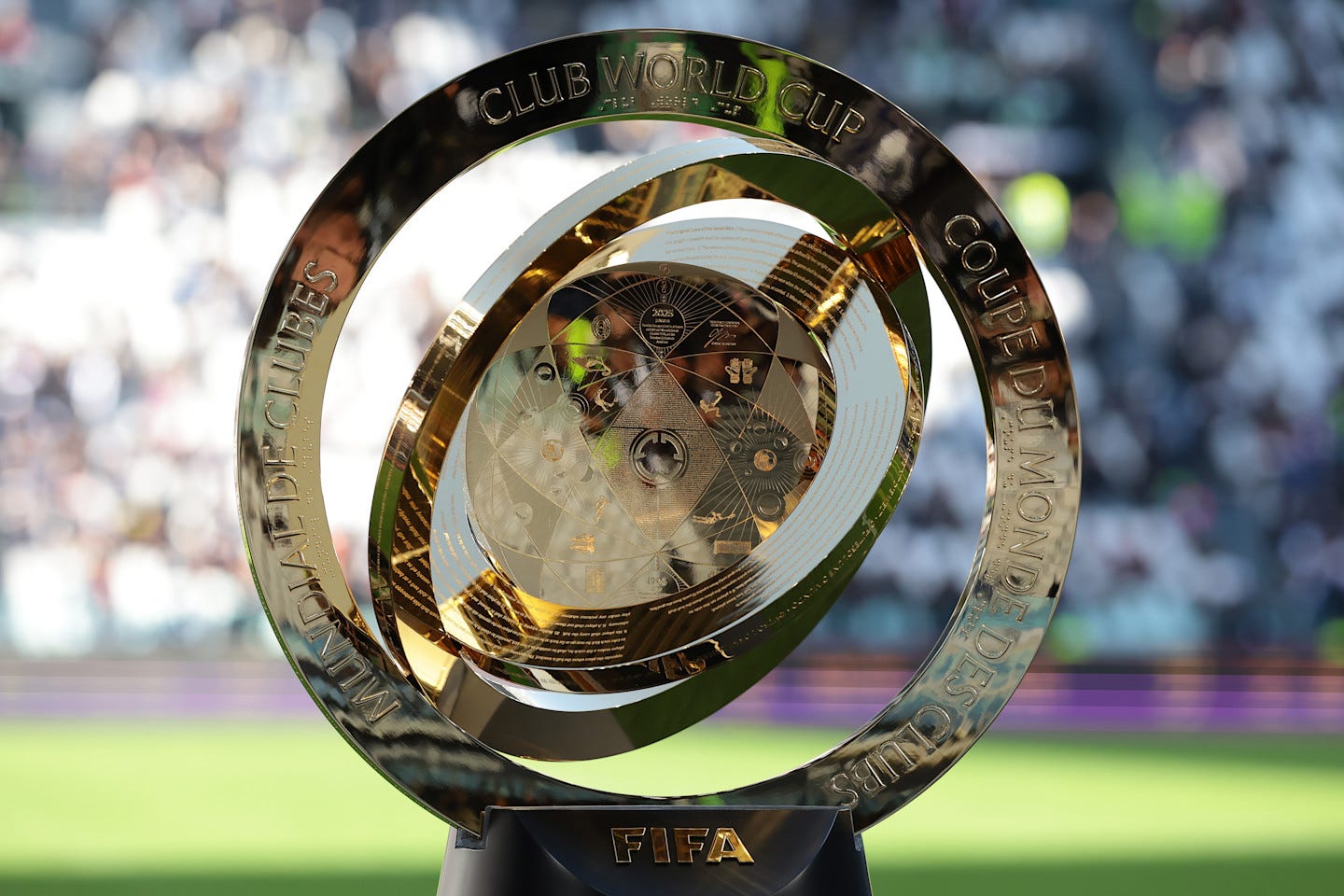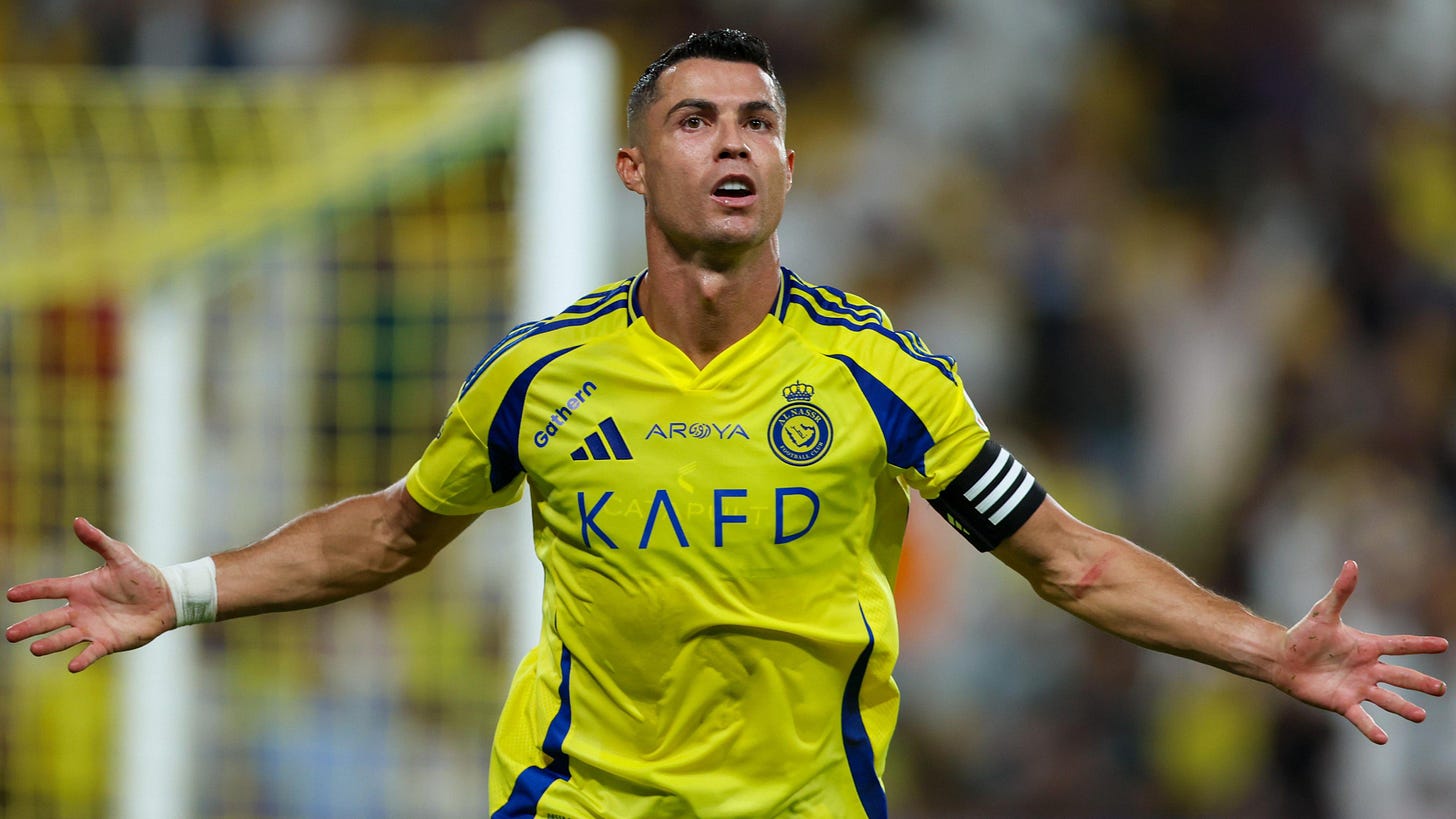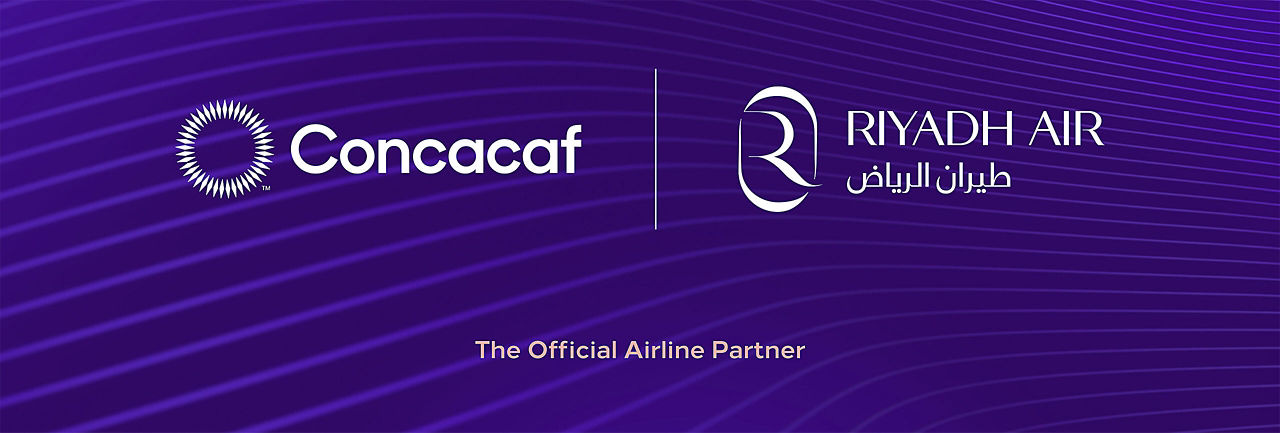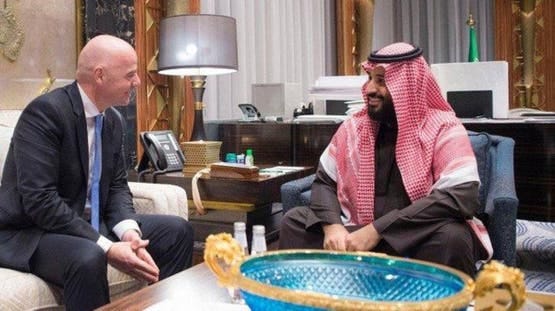18 Ways in Which Saudi Arabia Bought the Club World Cup
They own a club, they sponsor the tournament, they provide the prize money, they own the media rights, they fly players in, and it's just the beginning,
The Club World Cup begins this weekend. Much has been made about the cozy relationship between FIFA and Saudi Arabia, but the full extent of Saudi entanglement in the 2025 FIFA CWC is staggering.
What follows is a detailed exposé of how Saudi Arabia’s wealth and influence have permeated nearly every facet of this expanded tournament. The tone is not accusatory of crimes per se, but the facts speak loudly: Saudi involvement is systemic, overt, and impossible to ignore. Each point is evidence-driven, highlighting a distinct connection that, taken together, shows how Saudi Arabia effectively “bought” a central role in the CWC’s present and future.
The FIFA CWC trophy on display at Stamford Bridge in London ahead of the 2025 tournament. Saudi Arabia’s influence looms behind the scenes of this gleaming prize. Source: FIFA.
1. A Saudi-Owned Club Is Competing on the Global Stage
Al-Hilal, one of Asia’s most successful clubs, will represent Saudi Arabia in the 32-team CWC – and crucially, it is majority-owned by Saudi Arabia’s Public Investment Fund (PIF). In 2023, PIF acquired 75% stakes in Al-Hilal and three other top Saudi clubs as part of a nationwide “privatization” drive. This means a club effectively controlled by the Saudi state is now vying for the title of world champion. This is unprecedented in FIFA history: the government’s sovereign wealth fund isn’t just backing a team, it owns one of the contenders.
2. PIF Is an Official Sponsor of the 2025 CWC
Saudi Arabia’s PIF hasn’t stopped at club ownership – it has also signed on as a top-tier commercial partner of the CWC itself. In June 2025, FIFA announced PIF as an “official partner” of the tournament in the United States The deal’s value wasn’t disclosed, but its significance was clear: one of world football’s biggest new events is financially underwritten in part by the Saudi sovereign fund. FIFA’s own press release touted that the partnership “expands PIF’s global footprint in sports” and reflects a “shared commitment with FIFA to fuel growth and engagement in football”. In plainer terms, Saudi money is helping pay for the show – with FIFA happily welcoming the infusion of cash.
So the same Saudi fund sponsoring the tournament is the owner of one of its participating clubs. Al-Hilal’s majority owner is now bankrolling the broader competition in which Al-Hilal plays. It’s as if a Champions League sponsor directly owned one of the clubs in the Champions League – a scenario that would normally set off alarm bells. FIFA has not openly acknowledged any conflict, but the arrangement is ethically fraught.
3. Saudi Cash Backs the $1 Billion Prize Money Pot
To entice the world’s top clubs to participate in a new expanded CWC, FIFA needed a massive prize fund – and Saudi state money came to the rescue. The tournament’s prize pool is about $1 billion, spread among the 32 teams, an eye-watering sum only made possible by Saudi-backed deals.
FIFA’s partnership with PIF wasn’t just decorative: Saudi investment is literally funding the prize money that clubs like Real Madrid, Manchester City, and others will receive.
4. Al-Hilal Is Guaranteed a Windfall – From Saudi’s Own Fund
One telling detail: Al-Hilal, by mere entry into the group stage, is assured at least $9.55 million from the prize pool. That money ultimately originates from the Saudi-backed investment fueling the tournament. In a sense, Saudi Arabia is paying itself – the nation’s fund sponsors the event, and the club it owns reaps the rewards. For Al-Hilal, the guaranteed payout exceeds what many clubs earn for winning their continental titles. Tthe tournament sponsor’s team will directly benefit from the sponsor’s money.
5. Saudi-Backed DAZN Deal: Controlling the TV Rights
The fingerprints of Saudi financing are also on the tournament’s broadcast rights. In December 2024, FIFA struck a global media deal with streaming service DAZN to cover the CWC – and just weeks later, it emerged that Saudi investors (widely believed to be PIF or related entities) injected around $1 billion into DAZN. This sequence was hardly coincidental. Saudi state money helps to bankroll DAZN’s ability to pay for the rights, which in turn largely funded the CWC’s lavish prize fund It’s a complex financing loop, but the net effect is simple: Saudi Arabia’s wealth greased the wheels for the TV deal that made the expanded event financially viable. No Saudi cash, no $1B media rights windfall.
6. Al-Hilal’s Roster: A Saudi-Funded All-Star Team
Saudi Arabia’s strategy to excel on the world stage includes supercharging Al-Hilal’s squad with international stars – at astronomical expense. In the 2023-24 season, Al-Hilal went on a €375 million spending spree, signing the likes of Neymar (€90m transfer, with a salary reportedly around $100m a year), Aleksandar Mitrović, Ruben Neves, Sergej Milinković-Savić, Kalidou Koulibaly and more. This was no ordinary club spending; it was fuelled directly by PIF’s takeover and injection of funds. This was not always successful: Neymar left the club after one goal and seven appearances due to an ACL injury. But still the Saudi state went on a shopping binge to help Al-Hilal compete.
7. The Saudi “Privatization” Project that Centralized Power
How did Al-Hilal suddenly get the means to sign half a dozen world-class players? The answer lies in Saudi Arabia’s Sports Clubs Investment and Privatization Project. In mid-2023, PIF directly assumed control of four of the country’s biggest clubs – Al-Hilal, Al-Nassr, Al-Ittihad, and Al-Ahli – each now 75% owned by the fund.. By consolidating club ownership under the sovereign fund, Saudi Arabia can direct resources and strategy from the top. This centralization is what allowed an unprecedented spending blitz that put Neymar in a blue Al-Hilal shirt and Karim Benzema in an Al-Ittihad kit, among others. The CWC is the immediate beneficiary of this arms race, as Al-Hilal arrives with a roster that simply wouldn’t exist without government-engineered club privatization.
8. FIFA and PIF Tried to Force Cristiano Ronaldo Into the Tournament
Behind the scenes, there were efforts to have Cristiano Ronaldo switch teams just for the tournament. Ronaldo is under contract at Al-Nassr (another PIF-owned club) and did not qualify for the CWC – so Saudi officials discussed moving him to Al-Hilal on a short-term arrangement. According to media reports, PIF pushed for the star forward to join Al-Hilal’s CWC campaign, even if only for the summer of 2025. The idea sparked tension – Al-Nassr’s camp was furious at the prospect of their rival club “borrowing” Ronaldo to boost Saudi chances in the U.S.
And PIF weren’t alone. FIFA President Gianni Infantino himself added fuel to the Ronaldo-to-Al-Hilal story. He publicly hinted that “Cristiano Ronaldo might play in the CWC” despite Al-Nassr not qualifying but that there was a “unique transfer window” that could allow players to be registered for the tournament outside normal club seasons. Infantino all but invited clubs to make use of this exception – a wink and nod to the Ronaldo situation The overtone was clear: FIFA was keen to have the Portuguese icon, and global marketing magnet, on the pitch in America, even if it meant facilitating a one-off transfer.
The dream of a Cristiano Ronaldo vs. Lionel Messi showdown proved too elusive for now. And we’ll leave aside the shenanigans Infantino and FIFA pulled to make sure Messi’s Inter Miami would host and play in the CWC.
9. A Special Transfer Window
That “unique transfer window” Infantino referenced was no accident – it was a rule crafted for this expanded CWC. FIFA created a dedicated registration period for clubs to add players between the end of the European season and the tournament in June 2025.
The timing conveniently allows scenarios like Ronaldo’s: a player contracted elsewhere could temporarily join a CWC team. While officially for all clubs, this window was clearly influenced by the Saudi situation. FIFA bent its own calendar norms to make room for high-profile cameos.
10. Saudi Arabia Hosted the Last CWC
Saudi involvement didn’t start in 2025. In fact, FIFA had already handed Saudi Arabia hosting duties for the previous CWC in December 2023. In a unanimous vote, Saudi Arabia was selected to stage the 7-team tournament in Riyadh.The event went smoothly – and notably, Saudi’s own Al-Ittihad got to participate as the host club. FIFA’s decision came swiftly after Al-Hilal had reached the final of the 2022 edition. The 2023 hosting gig burnished Saudi Arabia’s credentials and deepened its relationship with FIFA. It was a dress rehearsal in more ways than one: a chance to prove logistical capability, curry favor within FIFA, and set the stage for bigger ambitions like the 2034 World Cup bid that was already brewing.
11. Rewarded with the 2034 World Cup After a Flurry of Deals
In late 2024, just as many of these partnerships and investments were falling into place, Saudi Arabia effectively secured hosting rights for the 2034 FIFA World Cup. It was an uncontested sprint – rival bidders dropped out, leaving Saudi Arabia as the only candidate and allowing FIFA to confirm the award mere weeks after the bid process opened. Not coincidentally, this came on the heels of Saudi money being promised all over FIFA’s ventures: within a span of months, Aramco was signed as a major FIFA sponsor (March 2023), Saudi got the 2023 CWC, PIF partnered on the 2025 CWC, and the DAZN rights deal (with Saudi investment) was inked – then voilà, World Cup 2034 was Saudi’s. As one analyst put it, the Aramco sponsorship “became inevitable once Saudi Arabia was all but sealed as the 2034 host”. While FIFA will insist no quid pro quo occurred, the timing screams otherwise. Saudi’s deep pockets and FIFA’s decisions aligned so neatly that it’s hard not to see a pattern of backscratching at the highest level.
12. Aramco: Saudi Oil Money Flows into FIFA’s Coffers
Beyond the CWC, Saudi Arabia’s influence spans FIFA’s entire portfolio thanks to Saudi Aramco. The state-owned oil giant signed a four-year deal as a FIFA “Major Worldwide Partner” through 2027 This sponsorship – reportedly worth upwards of $100 million per year – gives Aramco (and by extension the Saudi state) prime branding at FIFA events, from the men’s World Cup to youth tournaments. FIFA confirmed the Aramco partnership in early 2023, despite raised eyebrows about an oil company backing a sport touting sustainability. In FIFA’s eyes, In plainer terms, Saudi petro-dollars are now an integral part of FIFA’s budget. Even if Aramco’s logo won’t be on the CWC advertising boards, its cash is in the same ecosystem paying for the show.
13. Concacaf Has a Formal Partnership with PIF
It’s not just FIFA – even regional confederations are on Saudi’s payroll now. In August 2024, Concacaf (the federation for North and Central America and the Caribbean) announced a multi-year “strategic partnership” with PIF. This deal, coming from the very confederation hosting the CWC in the U.S., aims to “support the confederation in developing all levels of football across our region”, according to Concacaf’s president.
Translation: PIF will pour money into Concacaf competitions and programs. The partnership gives PIF and its affiliates high-profile branding at Concacaf events. In fact, Concacaf’s tournaments now feature PIF’s new airline, Riyadh Air, as the official airline partner, thanks to a tandem sponsorship agreement.
14. Riyadh Air: The Saudi Airline Now Flying the Concacaf Flag
As part of the PIF-Concacaf arrangement, Riyadh Air – a new airline wholly owned by PIF – became the official airline partner of Concacaf in 2024. This means at Concacaf Gold Cups, Champions League, and other regional tournaments, you’ll see Riyadh Air’s branding alongside PIF’s. The airline, which doesn’t even begin operations until 2025, is ambitiously planning 100 routes by 2030. It’s also notably the shirt sponsor of Spain’s Atlético Madrid, another PIF venture into global football. By aligning with Concacaf, Riyadh Air (and by extension Saudi Arabia) secures a marketing footprint throughout the Americas.
15. Infantino’s Close Ties to Saudi Power Brokers
The dramatic expansion of the CWC and Saudi Arabia’s deep involvement in it did not happen without friendship at the top. FIFA President Gianni Infantino has built unusually close ties with Saudi Arabia’s leadership since at least 2018. He has been frequently seen in the company of Crown Prince Mohammed bin Salman (PIF’s chairman), including as a VIP guest of MBS at high-profile events. Infantino relocated much of his personal operations to the Middle East, moving to Qatar for a time, and has openly praised Saudi’s “vision” for football. It is Infantino’s FIFA that aggressively pushed the expanded CWC, a project he has made his personal mission. In Saudi Arabia, Infantino found both a willing partner and a beneficiary of this project. The Crown Prince gains prestige and soft power; Infantino gets the financial muscle to realize his tournament dreams. It’s a symbiotic relationship – and the 2025 CWC is perhaps its grandest mutual endeavor to date, at least until the 2034 World Cup.
16. The CWC: Infantino’s Pet Project, Saudi’s Stage
Infantino has candidly treated the new 32-team CWC as a “personal project”, pouring energy into making it a reality. This ambition aligned perfectly with Saudi Arabia’s goals. The Kingdom craves major events and global legitimacy in sport; Infantino needed heavy backing to launch an expanded tournament. So we saw a convergence: Infantino courted Saudi support, and Saudi Arabia leveraged Infantino’s plans to insert itself at every level of the event. From naming the host (the USA got 2025, but Saudi Arabia was rumored to have been interested) to structuring the finances, the fingerprints of this alliance are evident.
One might say Saudi Arabia helped will the expanded CWC into existence. Without huge infusions of cash and a guarantee of future partnership (e.g. 2034 World Cup hosting), FIFA might not have risked such a colossal new venture. Infantino himself has shown zero hesitation in deepening FIFA’s Saudi ties – he even invited Saudi’s tourism board to sponsor the Women’s World Cup (a plan later shelved after backlash). In short, the CWC’s new era is as much a victory for Saudi influence as it is for Infantino’s legacy.
17. European Clubs Were Lured by the Saudi-Funded Jackpot
It’s worth noting that Europe’s elite clubs – historically lukewarm on the CWC – agreed to this expanded format largely because the prize money is enormous. FIFA needed a carrot to get buy-in from clubs like Real Madrid, Bayern Munich, and Manchester City, who already have packed calendars. That carrot was the Saudi-backed $1 billion purses. Even teams that might have been skeptical of a month-long FIFA competition in the summer have come around because the payday justifies it. As mentioned above, teams get millions just for showing up. In essence, Saudi Arabia bought not only the tournament infrastructure but also the participants’ enthusiasm.
18. Even the Women’s World Cup Was a Target for Saudi Money
One telling anecdote about the breadth of Saudi’s ambitions: FIFA nearly had Visit Saudi (the Saudi tourism authority) as a sponsor of the 2023 Women’s World Cup. The plan, floated by Infantino’s FIFA, provoked outrage from women’s footballers and the tournament’s co-hosts (Australia and New Zealand), given Saudi Arabia’s abysmal record on women’s rights. Ultimately, FIFA scrapped the idea in March 2023 after the backlash.
Add up all these points, and the picture is overwhelming: Saudi Arabia’s presence in the 2025 CWC is not just significant, it’s systemic.
There is no aspect of the event - the teams, the prize money, the broadcasting rights, the airlines, the infrastructure of international soccer - that Saudi influence hasn’t taken over.







Great article chris im just wondering with such a big event do you think we will see potential match fixing in the cwc or is it to big of a stage for criminals to get away with something like this?